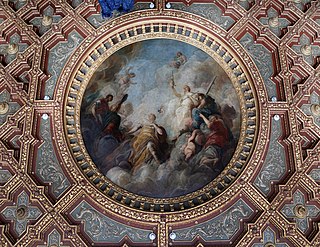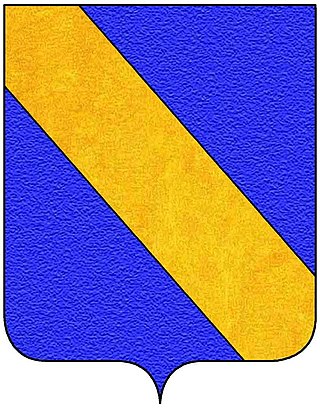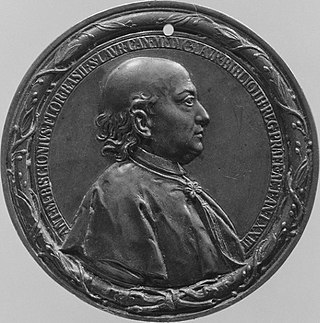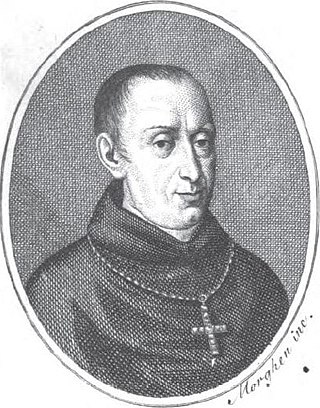
The House of Foscari was an ancient Venetian patrician family, which reached its peak in the 14th–15th centuries, culminating in the dogeship of Francesco Foscari (1423–1457).

Bernardo Dovizi of Bibbiena was an Italian cardinal and comedy writer, known best as Cardinal Bibbiena, for the town of Bibbiena, where he was born.

Giorgio Anselmi was an Italian painter.

Domenico Maria Canuti was an Italian painter of the Baroque period, active mainly in Bologna and Rome. He was a major painter of fresco decorations. His ceiling decorations showed a mix of Bolognese and Roman influences.

Giovanni Battista Zelotti was an Italian painter of the late Renaissance, active in Venice and her mainland territories.

Giuseppe Angeli was an Italian painter of the late-Baroque, known for depicting both genre and religious subjects.

Domenico Ambrogi was an Italian painter from Bologna of the 17th century, also called Menichino or Menghino del Brizio, after a master. Mainly known as a decorator of quadratura. He is also known as Domenico degli Ambrogi. He trained with Francesco Brizio, Bernardino Baldi, and Denis Calvaert.

Antonio Randa was an Italian painter of the classicist period, active in Ferrara, Modena, Rovigo, Florence, Comacchio and his native Bologna.
Antonio Gaspari was an Italian architect of the late-Baroque, active in both Venice and the terrafirma of the Veneto. He was a pupil of Baldassarre Longhena, and upon his master's death in 1682, he completed some of his projects, including Longhena's most famous work, the imposing church of Santa Maria della Salute. He likely died in his homestead in Castelguglielmo, in Polesine. One of his sons, Giovanni Paolo Gaspari (1712-1775), was a painter active mainly in Germany.

Giovanni Rucellai, known as Giovanni di Bernardo Rucellai, was an Italian humanist, poet, dramatist and man of letters in Renaissance Florence, in Tuscany, Italy. A member of a wealthy family of wool merchants and one of the richest men in Florence, he was cousin to Pope Leo X and linked by marriage to the powerful Strozzi and de' Medici families. He was born in Florence, and died in Rome. He was the son of Bernardo Rucellai (1448–1514) and his wife Nannina de' Medici (1448–1493), and the grandson of Giovanni di Paolo Rucellai (1403–1481). He is now remembered mostly for his poem Le Api, one of the first poems composed in versi sciolti to achieve widespread acclaim.

Antonino or Antonio Leto was an Italian painter, painting mainly genre/landscape subjects in an impressionistic style.

Fabio Canal or Canale was an Italian painter of the late Baroque era, active mainly depicting history and sacred subjects in his native Venice.
Giovanni Battista Canal or Canale was an Italian painter of the late Baroque and early Neoclassical era, active mainly depicting history and sacred subjects in his native Venice.
Vincenzo Galli was an Italian opera singer and impresario. Considered an outstanding basso buffo singer, he created many roles on Italian stages, including in two of Donizetti's operas: Ivano in Otto mesi in due ore and Cesare Salzapariglia in Le convenienze ed inconvenienze teatrali. Luigi Ricci composed the role of Michelotto in his opera Chiara di Rosembergh specifically for Galli's voice.

The Capizucchi family was a noble Roman family. Considered one among the oldest families in Rome, it was deeply rooted in the Roman nobility because of the gallantry of many members. The family died out in the 17th century, and its name came to an end in 1813. The Capizucchis had their homes in Campitelli rione, at the foot of Capitoline Hill, and there also lay their palace. This still exists and is located between two squares, Piazza Campitelli and the one that took its name from the family, Piazza Capizucchi.

Antonio Maria Biscioni was an Italian historian, philologist, and librarian for the Laurentian library of Florence. He was born in Florence and entered religious orders. Among his pupils were Giovanni Gaetano Bottari. He wrote a history of Pistoia in the 14th-century: Historie pistolesi, ovvero delle cose avvenute in Toscana dall'anno 1300 al 1348. He catalogued the Hebrew and Greek biblical texts in the Laurenziana: Bibliothecae Ebraicae Graecae Florentinae, sive Bibliothecae Mediceo-Laurenzianae, Volume 1. He was a member of the Accademia della Crusca.

Salvatore Maria Di Blasi was an Italian Benedictine monk, scholar, and librarian.

Leopoldo Piccardi was an Italian politician and civil servant, who served as Ministry of Industry and Commerce of the Badoglio I Cabinet, the first after the fall of the regime. After the war he became a founding member and secretary of the Radical Party until a scandal over his participation in anti-Semitist conferences during the Fascist period forced him to resign.

Federico Maria Giovanelli was Patriarch of Venice from 1776 to his death.
















